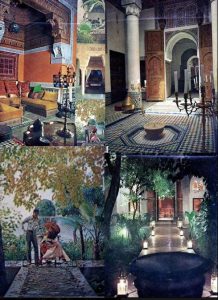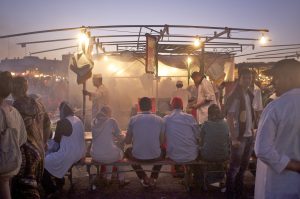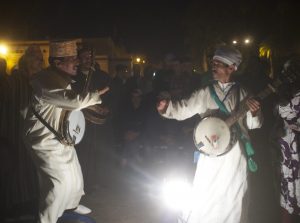



This is a sad, symbolic part of the Brian Jones story which features two other doomed icons of the ’60s jet set, Paul and Talitha Getty, of whom Yves Saint-Laurent famously remarked: “I knew the youthfulness of the Sixties (…) Talitha and Paul Getty lying on a starlit terrace in Marrakesh, beautiful and damned, and a whole generation assembled as if for eternity where curtain of the past seemed to lift before the extraordinary future.”
There are many speculative guesses about Brian Jones’s ventures to Morocco. I believe I have finally rationalised them, and what has variously been referred to as a venture to Joujouka in March 1968, or to Marrakesh in July 1968, turns out to be a trip to Marrakesh with Glyn Johns in March 1968. The trip started out with a coherent, visionary plan – to record Gnawa rhythm tracks, onto which Brian could overdub funk musicians. Glyn Johns, a friend of Ian Stewart’s who knew Brian in good times and bad, views this episode as another example of Brian’s unreliability. Perhaps he was right. Yet it’s also worth pointing out that this episode, in March 1968, was Brian’s first visit to the Jemaa El-Fnaa since March 1967 – when Brion Gysin had taken him around the square as a ruse, to distract him while Keith, Mick and Anita did a moonlight flit.
Brian’s abandonment by his fellow Stones was obviously a central event in his life – some speculate it was the loss of Anita that wounded him grievously, I firmly believe that the real wound came from the treachery of his fellow Stones, the men he considered brothers.
Recently, in the Daily Mail, Craig Brown suggested it was Brian that was the nasty, treacherous Stone. Yet remember, his fellow Stones never confronted Brian about his behaviour in Marrakech; they simply abandoned him, alone, with no money and no transport. Make your own judgement about who the bad guys were.. and then imagine the spectacle of Brian, with Paul and Talitha Getty, in that lonely, echoey palace in Marrakesh.
So, you travelled with Brian to Marrakesh in March 1968 – did you both venture out to the Jmaa El Fnaa?
Glyn Johns: “Actually, I went out int to the square [on my own].. I went specialyl for the Gnawa, I recorded lots of stuff, which was all given to Brian… he wasn’t actually with me when I recorded, so I just recorded whatever I thought sounded interesting.”
Were there problems with the recording? I was told there was an issue with levels, or tape hiss?
“I’m not aware of any problems… there was no problem with any of the tapes I know of.”
Ah, ok. What was the plan for the recordings?
“I believe Brian’s intention was to tape what the Gnawas were doing, take the tapes to New York and overdub black American musicians, that Cold Sweat funk style, over the top. To combine the two genres.”
How was the square, when you went out there?
“It was jam packed with people.. the strangest musicians I have ever seen in my life, it was fascinating. I was only a kid, really, and I was blown away by the whole thing, it was amazing. There was everything there, it was a bloody travelling circus, lots of snake charmers, musicians, everybody and anybody, all trying to squeeze a few bucks out of you, whatever you were doing. And if they saw you with a tape recorder, which they did with me, they’d stop and go “Make pay, make pay!”
Why didn’t Brian come to the square?
“I don’t know that it’s fair to put it… but he was stoned, out of his tree. Not up to it. He was incapacitated… he got very stoned the minute he arrived and remained that way until we left.”
Actually, Glyn went on to explain, Brian wasn’t incapacitated the whole time. Glyn, who had recorded both the very early Stones demos, and Brian’s first ventures into songwriting, for the Mord und Totschlag soundtrack, went into detail about his recordings on the square (which I visited recently, and have described in a feature which should be out this weekend). He recorded several different outfits… but what hasn’t been revealed before is that one group of musicians returned to Brian and Glyn’s holiday accommodation, Paul and Talitha Getty’s palace in Marrakesh, a fairy-tale edifice which had been remodelled by Bill Willis – “a very sensible, beautiful 1830 Moroccan house with just the right garden,” according to Cecil Beaton, a man with intimidatingly high aesthetic standards.
Brian was specifically interested in the Gnawa style, and Johns managed to entice one group back to the Gettys. The Gettys’ palace, alone, makes for an amazing story, for the couple were star-crossed; Talitha, who was born in Java and spent her toddler yearsin a Japanese prison camp, died of a heroin overdose in Rome, July 1971. Paul Getty had a similarly troubled existence, which is well documented.
Glyn: “They played in this banqueting hall in the palace and I recorded that to – that was totally different ‘cos it was done without any background noise. It was amazing. It was all percussion, nothing other than the drums. By now Brian was compos mentis… and it was just just Brian, me, Paul Getty Jr and Talitha in this extraordinary, huge setting. Like nowhere I’ve been before or since.”
Photos are of the Getty House and Talitha from a Vogue shoot, plus Hassan Khontija and his Berber group at the Jmaa during my own trip there .
